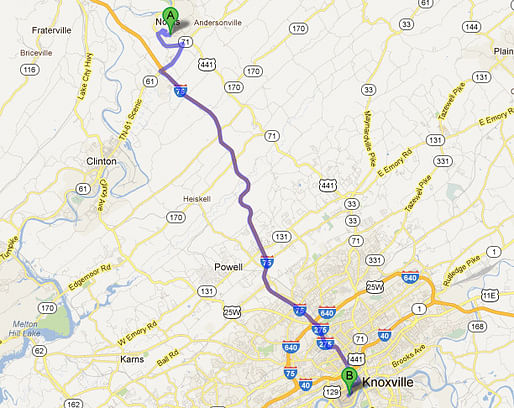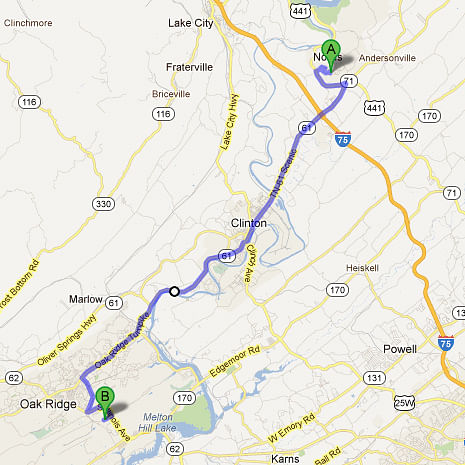
Although the town of Norris is pedestrian friendly, traveling outside town limits requires transportation by car. While living in downtown Knoxville, we didn’t rely too much on our cars. Ken could walk, bike, or ride the trolley to the university. Since I telecommute, the only driving I did was for a once a week trip to the grocery store, and errands or appointments that couldn’t be taken care of downtown. It was a nice change of pace not having to fill gas tanks weekly like we did in Phoenix; with the exception of some longer weekend trips, we weren’t using much gasoline to get around town.

gas prices on the rise (source)
Our transportation situation has changed now that we live in Norris. Ken has to drive to campus; the commute is about 23 miles one way and takes about 30-40 minutes depending on traffic. However, his time spent on the road is equivalent to the amount of time it took to walk or ride the trolley to campus from downtown Knoxville.

23 mile commute from NNH to UTK
I’m still telecommuting part-time, but this semester I’m also completing a practicum with a company in Oak Ridge. This means that half of the week I’m driving about 21 miles one way for 40-45 minutes to get to the office. It’s a scenic route, but not on the freeway and with a fair amount of stop-and-go traffic.

21 mile commute from NNH to Oak Ridge
As I’m driving more often now, I’m reminded that a daily commute has financial impacts. Gasoline prices continue to rise. Although both our cars get close to 30 miles per gallon so we’re not filling up quite as often, it’s impossible to escape the price hikes. Every driver has maintenance and insurance costs, and maybe a car payment as well. Other impacts are on personal time—no matter the length of the commute, and on the environment—air quality being affected the most.

(source)
The New Norris House is very energy efficient, but we have to drive while living here. I’m left wondering if it’s better in the long run to live in a highly efficient home and commute to work, or eliminate a commute and live close to work and other amenities in a house or apartment that’s not as energy efficient?
Learn more about our project at www.thenewnorrishouse.com.
The New Norris House is a design/build effort from the University of Tennessee's College of Architecture and Design. Began in 2009, the home was designed and built by UT students in collaboration with Clayton Homes. The built project is now complete and the final phase of the project has begun. A team of 4 people (2 living in the home, and 2 graduate researchers) will rigorously document the experience via qualitative assessments and quantitative measurements, posting results to this blog.





2 Comments
My gut would say to be closer and have less of a commute. Honestly though that is more personal lifestyle choice than known calculation.
it's a good question.
the books say density is the answer, but my experience says it is mixed bag.
i have long commute by train every morning. so does my wife but in opposite direction. we would love to live closer to work but can't imagine more density making that possible (we live in tokyo, close to the center). already the downside of density is enough to make us wish for more space but the commute from a suburb would be hellish. i get the feeling there is no easy answer to this problem.
Block this user
Are you sure you want to block this user and hide all related comments throughout the site?
Archinect
This is your first comment on Archinect. Your comment will be visible once approved.